Description
Director Mk2 DA Converter and Preamplifier
The Director Mk2 is the derivative of our reference preamplifier Director:
The all new high voltage digital to analog converter now supports 32 bit and sample rates up to 768kHz as well as DSD4.
Fans of analog tape machines or external audio processing can insert their beloved gear in the Tape Monitor loop.
Now there is a total of six analog inputs. Two of which are balanced with XLR connectors.
The housing has grown in height to provide space for the big aluminum volume control with marker LED and two mechanical VU meters.
Director Mk2 is the heart of the stereo system to which all components are being connected:
Computer, player, phono preamp like the Phonos, headphone amps like the Phonitor xe or the Phonitor e and power amplifiers like the Performer s800 or Performer m1000 or active loudspeakers instead.
Preamplifier
Director Mk2 is a full-fledged stereo preamplifier for connecting up to ten stereo input sources.
Six of which are in the analog domain offering two balanced XLR and four RCA stereo inputs.
Four inputs are in the digital domain: AES/EBU, USB, COAX, OPTICAL.
Power amplifiers or active loudspeakers are connected via balanced XLRs and a headphone amplifier is connected to the Direct Out.
Volume
Volume is controlled strictly in the analog domain – for good reason.
Commonly volume is set in the digital domain as part of a DAC chip’s functionality. The down side is that the full bit resolution is only present at maximum playback volume.
But we never listen with the preamp’ volume turned up fully clockwise. As a result we always listen at a lower bit resolution and therefore with a diminished audio fidelity. An average listening level is about 30dB below maximum (0dBfs) and as the resolution shrinks by 1 bit per 6dB level drop the playback will have a 5dB lesser resolution.
It makes not a lot of sense to listen to high res audio then, does it?
Therefore we opted for an analog solution that gives you full bit resolution at all listening levels.
To control the 120V rail VOLTAiR volume stage we use an ALPS RK27 “Big Blue” potentiometer with excellent feeling and channel matching.
Being motorized Volume can be remotely controlled. Please refer to the chapter “Remote Control” for more information.
Sources
The rotary switch selects the input source, which is then shown in the dot matrix display: IN 1 to IN 6 for the analog inputs and AES/EBU, USB, COAX, OPTICAL for the digital inputs.
The detected sample rate of the selected digital input is displayed after about 2sec. (e.g. U768 = USB input, 768kHz sample rate).
The input source selection can also be remotely controlled when the selector is set to “Remote”. Please refer to the chapter “Remote Control” for more information.
Uber-DAC769 with DLP120
We have been looking at many DAC designs and we have always wondered why all the innovation happens on the digital side. Almost no innovation is to be found on the analog part for the DAC. Maybe that is because most designers have a background in digital engineering and as a result they apply standard ‘cook book’ designs on the analog side.
We, having a 30+ year background in analog audio designs, find cook book circuitries boring, inefficient and far from being superb. As already proven with the DAC in the predecessor we put innovation into the analog side of the DAC with astonishing results.
The output of the DAC chip is to be filtered with a low pass filter. This stage is typically designed with the same reference voltage that the DAC chip works on e.g. 5V. Think about this: the first stage that the analog waveform is exposed to has a headroom limited this tiny voltage. Now imagine this to be 120V! This is what we have done in the Director and of course in the Mk2.
The mandatory lowpass filter is built in 120V-VOLTAiR technology. The DAC768 features the new DLP120 lowpass filter board that contains two separate lowpass filters. Depending on the digital format the analog signals runs through the PCM or der the DSD filter.
The incredible headroom and the enormous dynamic range lets the analog wavefront come to life and evolve without any limitation. And that is audible. Very much so.
Velvet Sound DA Converter
The Director Mk2 is equipped with a completely new digital-to-analog converter board. It is an all new design based on the AK4490 Velvet Sound® DAC chip from AKM.
The new DAC supports PCM audio up to 768kHz sample rates with 32 bit and DSD audio playback up to DSD4 or DSD256.
It sports four digital stereo inputs: AES/EBU, USB, COAX, OPTICAL.
AES
AES (or more precise AES3 or AES/EBU) is a standard for the exchange of digital audio signals between professional audio devices. AES3 was jointly developed by the Audio Engineering Society (AES) and the European Broadcasting Union (EBU).
An AES signal can carry two coded PCM audio channels of up to 192kHz sampling rate.
The standard is defined under IEC 60958 Type I.
Type I connections use balanced, 3-conductor, 110-ohm twisted pair cabling with XLR connectors.
Coaxial
The consumer grade variant of AES is S/P-DIF (Sony/Philips Digital Interface). Worldwide it is the most commonly used method for digitally interconnecting audio equipment – typically the digital output of a CD player.
The connector is labelled “Coaxial”. Like AES it can carry two coded PCM audio channels up to 192kHz sampling rate.
The standard is defined under IEC 60958 Type II.
Type II connections use single-ended, 2-conductor, 75-ohm coaxial cable with RCA connectors.
Type II Optical connections use optical fiber with F05 connectors, which are more commonly known by their Toshiba brand name, TOSLINK. Type II Optical connections are also used in consumer audio and are also called “Optical”.
Like AES and Coaxial it supports sample rates up to 192kHz for two coded PCM audio channels.
USB
The most interesting input is the USB port for connection with a computer. The Director Mk2 supports both audio formats PCM and DSD. For PCM audio sample rates are supported up to 768kHz and for DSD audio sampling is supported up to DSD4 (quad-rate DSD) also known as DSD256 (256 times the CD sample rate of 44.1kHz).
When connected to a PC the Windows driver must be installed to playback audio files with a higher resolution than 44.1kHz or 48kHz.
On a Mac the install of a driver is not needed. Apple natively supports USB class 2 with sample rates up to 768kHz.
DSD Over USB
SACD or BluRay players typically do not put out the DSD stream for copy protection reasons. This means that an existing SACD/BluRay player can only be connected to the analog inputs of the Director Mk2.
To playback (non-encrypted) DSD files from a computer can only be handled over USB.
Specific software players like Audirvana Plus (Mac), Channel D Pure Music (Mac), J River Media Center (Mac/PC), Signalyst (PC), Foobar2000 (PC), JPlay (PC) support DSD playback.
The USB audio 2.0 specification defined several formats for the more common PCM approach to digital audio, but did not define a format for DSD. In 2012, representatives from many companies and others developed a standard commonly known as “DSD over PCM”, or “DoP” to represent and detect DSD audio within the PCM frames defined in the USB specification.
PCM & DSD
Pulse-code modulation (PCM) is a method of encoding sampled analog signals generally used for uncompressed audio. It is the standard form of digital audio in computers, Compact Discs, digital telephony and other digital audio applications.
Direct-Stream Digital (DSD) is developed by Sony and Philips for SACD (Super Audio CD) which should have become the designated successor of the CD (that was also designed by these two companies).
Since PCM and DSD are digital formats, there are other ways to play back high-resolution music. The highest possible resolutions are available on download portals like HD Tracks, Qobuz, HIGHRESAUDIO, primephonic, HDMusicStore, Bleep, Cybele, Gimell, HD-Klassik, 7 Digital etc.
DSD differs fundamentally from conventional PCM. While in a PCM stream, the amplitude of the analog signal is sampled regularly at uniform intervals, and each sample is quantized to the nearest value within a range of digital steps, DSD stores a sequence of single-bit values before applying a “decimation” process that converts the signal to a PCM signal.
A PCM stream has two basic properties that determine the stream’s fidelity to the original analog signal: the sampling rate, which is the number of times per second that samples are taken; and the bit depth, which determines the number of possible digital values that can be used to represent each sample. In the Director Mk2 PCM audio is supported up to sample rates of 768kHz (16 times 48kHz) and bit resolutions of up to 32 Bit.
In DSD audio the fidelity is determined by the rate of the 1-bit stream. The Director supports up to quad-rate DSD also known as DSD4 or DSD256. Single-rate DSD is the typical SACD/BluRay resolution and it is referred to as DSD1 or DSD64 because the sample rate is 64 times that of CD (44.1kHz) namely 2.8224 MHz. DSD4 samples at 11,2896 MHz, four times the SACD/BluRay rate. This is also referred to as DSD256 because the sample rate is 256 times that of CD.
The long-term average of a DSD signal is proportional to the original signal. DSD uses noise shaping techniques to push quantization noise up to inaudible ultrasonic frequencies. In theory, it only requires a lowpass filter to reconstruct the original analog waveform. In reality it is a little more complex. A one-bit signal cannot be dithered properly: most modern sigma-delta converters (like the DAC in the Director) are multi-bit.
Because it has been extremely difficult to carry out DSP operations (for example performing EQ, balance, compression) in a one-bit environment, and because of the prevalence of solely PCM studio equipment such as Pro Tools, Nuendo, Cubase, Logic, the vast majority of SACDs and DSD downloads—especially rock and contemporary music, which rely on multitrack techniques—are in fact mixed in PCM (or mixed analog and recorded in PCM) and then converted to DSD in mastering. It is kind of rare to find or identify a recording being multi-tracked and mixed in the analog domain. Merging Technologies has invented the DXD format with which theoretically a production can be recorded, mixed and mastered entirely in the DSD domain.
AMP CTL
When powering the Director Mk2 on or off up to two power amplifiers can be wire-linked and triggered for simultaneous power on/off.
To achieve this connect the AMP CTL sockets with 3.5mm mono-jack cables to the power amplifier. The Director Mk2 sends out a 12V trigger voltage on the sockets A & B to switch one or two stereo amps or two mono blocks on and off.
Remote Control
Volume as well as source input selection can be remotely controlled using any existing infra-red (IR) remote control. The cool part is that the Director Mk2 learns the remote commands.
Take, for example, the remote control of the CD player. Out of the many buttons there are maybe four you hardly use if at all and which do not directly trigger a function on the CD player.
Alternatively er suggest using the Apple remote control which is small, slick and offers just the buttons you need.
Assign Volume Up / Volume Down to two buttons and Next Input / Previous Input to two other buttons and let the Director Mk2 learn them. The procedures are described in the manual and in the video “Learning Remote Control”.
Make sure that the source selector switch is set to ‘Remote’.
VU Meters
The two VU meters display the source’s input level. It’s mechanical design ‘slows’ the measurement, averaging out peaks of short duration, and reflects thereby more the perceived loudness or ‘energy’.
VU means Volume Units. A typical VU meter shows a range of -20dB to +3dB. Our VUs go up to +5dB. A mastered CD can produce levels of up to +15dB which would glue the needles to the right side.
To prevent this the VU toggle switch allows selecting either 6 or 12. Meaning that in position 6 with the needle pointing at 0 the true value is +6dB and set to 12 means a true value of +12dB when the needle points at 0.
With the VU switch set to +12dB the VU meter can display levels up to +17dB. If the needle goes beyond that it does not indicated that the Director Mk2 is clipping. Thanks to the VOLTAiR technology there is still more than 15dB headroom. The Director Mk2 clips above +32.5dB input level!
Tape Monitor
The Tape Monitor function has become part of the Mk2 because many audiophiles requested it to insert tape machines or external processing gear.
In the 70s and 80s cassette recorders were very popular and a hifi preamp offered a tape monitor. Later this feature went away, but fans of recording and processing found the lack of this feature in today’s preamps being a real drawback.
Well, so we introduced this feature in the Mk2. It is now possible again to insert a tape machine and listen back while recording (tape monitoring) or to insert beloved equalizers or other processing devices to tune sound.
On the rear of the unit is a level calibration switch besides the tape send and tape return sockets. Consumer tape machines, cassette desks or consumer equalizers may clip when exposed to the levels that the Director Mk2 handles. To prevent peaks and distortion this switch reduces the outgoing level by 10dB and lifts it again by 10dB when coming back into the Director Mk2. Thereby no level difference will be audible and your gear perform on levels it is used to.
Analog Stereo Inputs
- 6 analog stereo inputs
- 2 x XLR, balanced (10 kOhm)
- 4 x RCA, unbalanced (47 kOhm)
- Max. input level: +32,5 dBu
Digital Inputs
- 4 digital inputs
- AES/EBU (XLR), balanced
- Coaxial SPDIF (RCA)
- Optical TOSLINK (F06)
- USB (B)
- 0 dBFS = 15 dBu
- Converter Chip AK4490-Velvet Sound
Sample Rates 32 Bit
- Encoded PCM (kHz): 44.1, 48 , 88.2, 96, 176.4, 192, 352.8, 384, 705.6, 768
- DSD: DSD1 (DSD64), DSD2 (DSD128), DSD4 (DSD256)
Outputs
- 2 analog stereo outputs
- Neutrik XLR, balanced, Pin 2 = (+)
- RCA, unbalanced (Direct Out)
- Impedance: 75 ohms (balanced)
- max. output level 32,5 dBu
Measurements
- Frequency range (analog): 10 Hz (-0.1 dB), 200 kHz (-1.2 dB)
- Crosstalk at 1 kHz: -108 dB (analog); -108 dB (digital)
- THD: 0.00992 % (analog 0 dBu); 0.0014 % (digital -1 dBfs)
- Noise (A-weighted): -102.5 dB (analog); -100.2 dB (digital)
- Dynamic range: 135 dB (analog); 115.2 dB (digital)
Internal Voltages
- Analog: +/- 60 V
- Digital: + 7 V and + 3.3 V
Power Supply
- Mains voltage (switchable): 230 V AC / 50 Hz or 115 V AC / 60 Hz
- Fuses: 230 V: T 500 mA; 115 V: T 1 A
- Power consumption: max. 40 VA
- Standby power consumption: 0.7 W
Dimensions (incl. feet)
- 278 mm W x 100 mm H x 330 mm D
- 10.95 in W x 3.94 in H x 13 in D
Weight
- 4.55 kg; 10.03 lbs (unit only)
- 5.7 kg; 12.57 lbs (shipping)
0 dBu = 0.775 V. Subject to change without notice

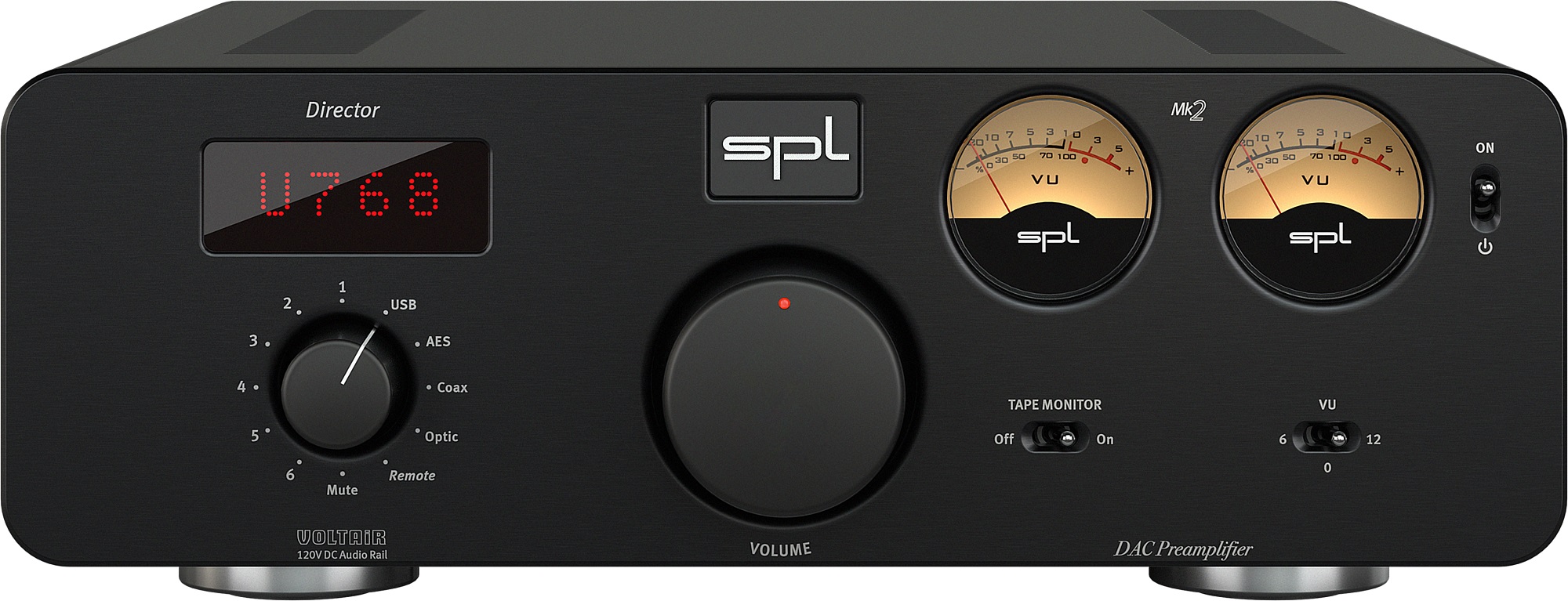
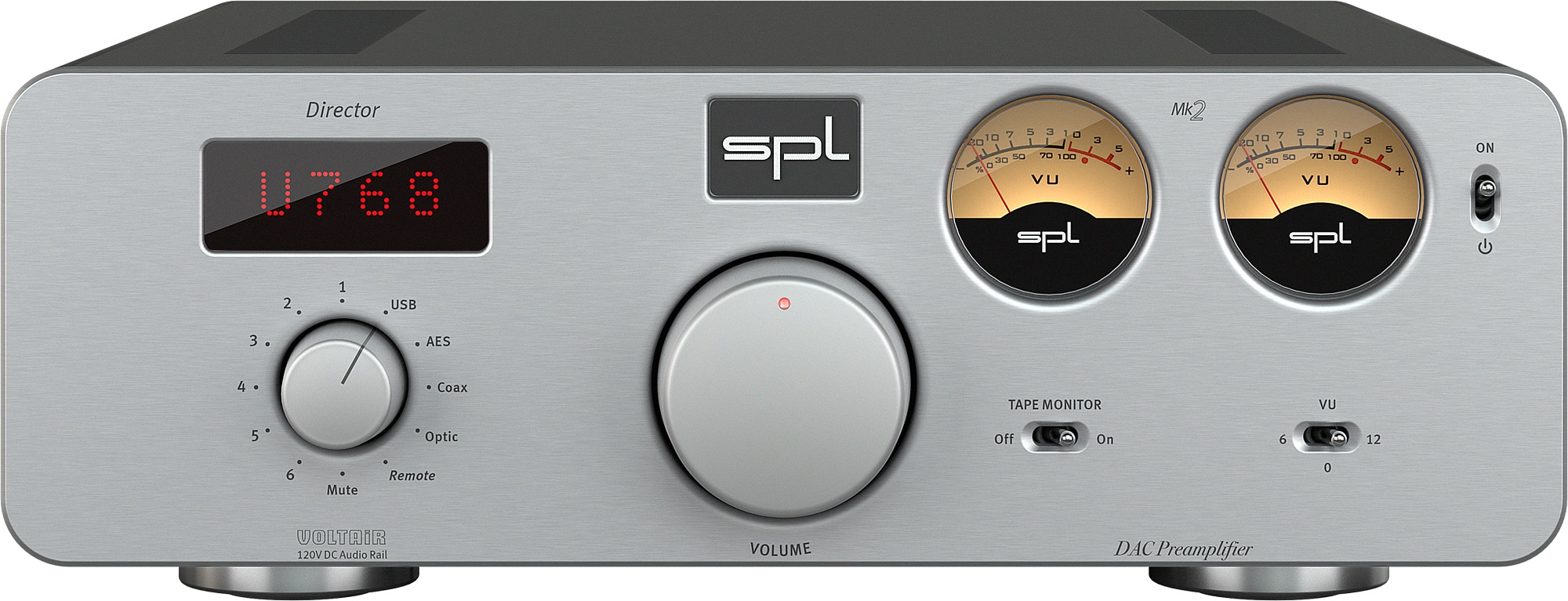


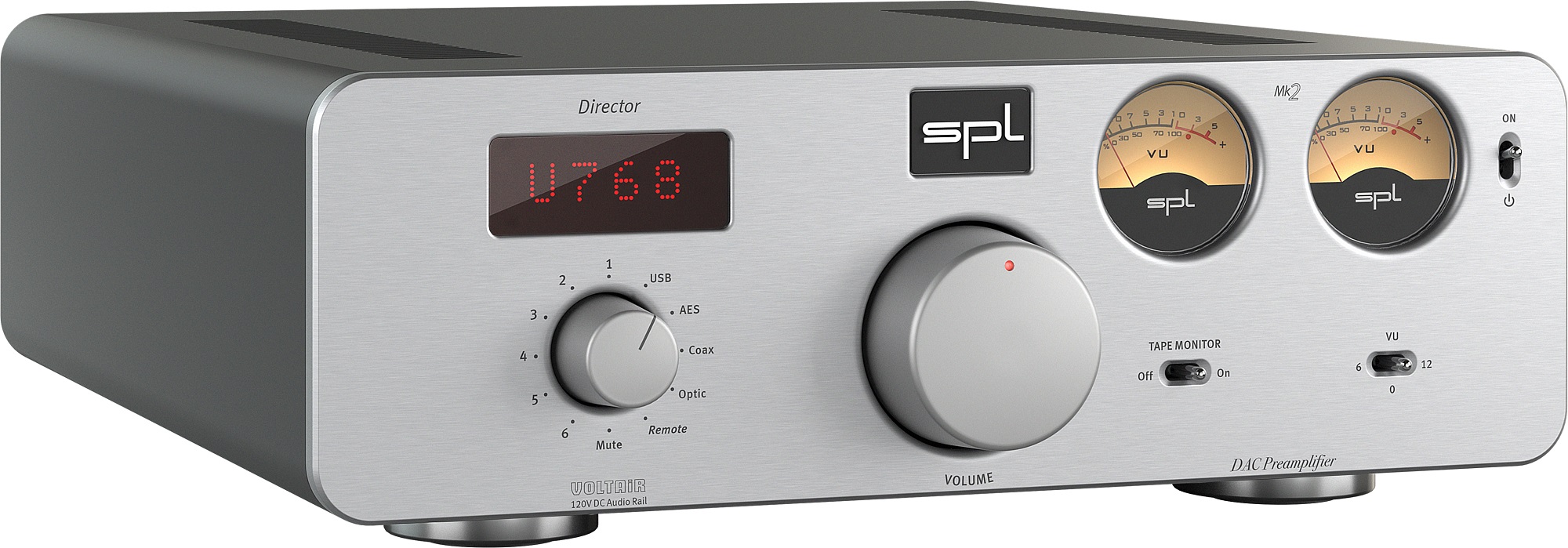
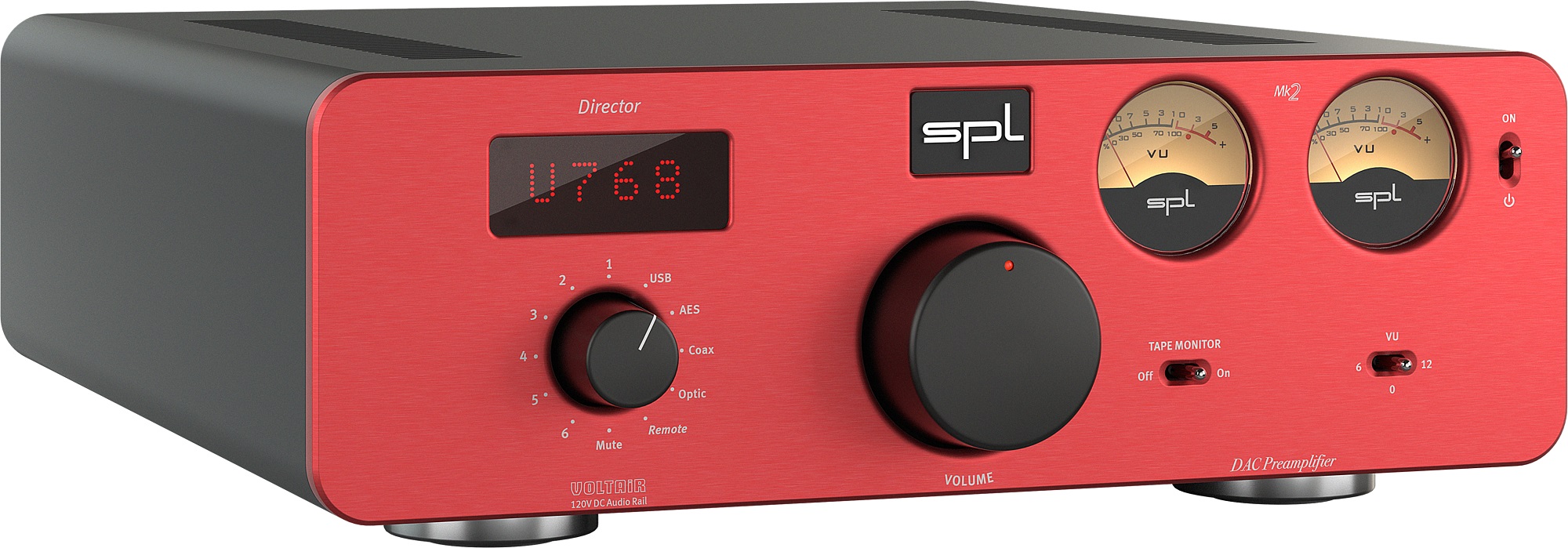
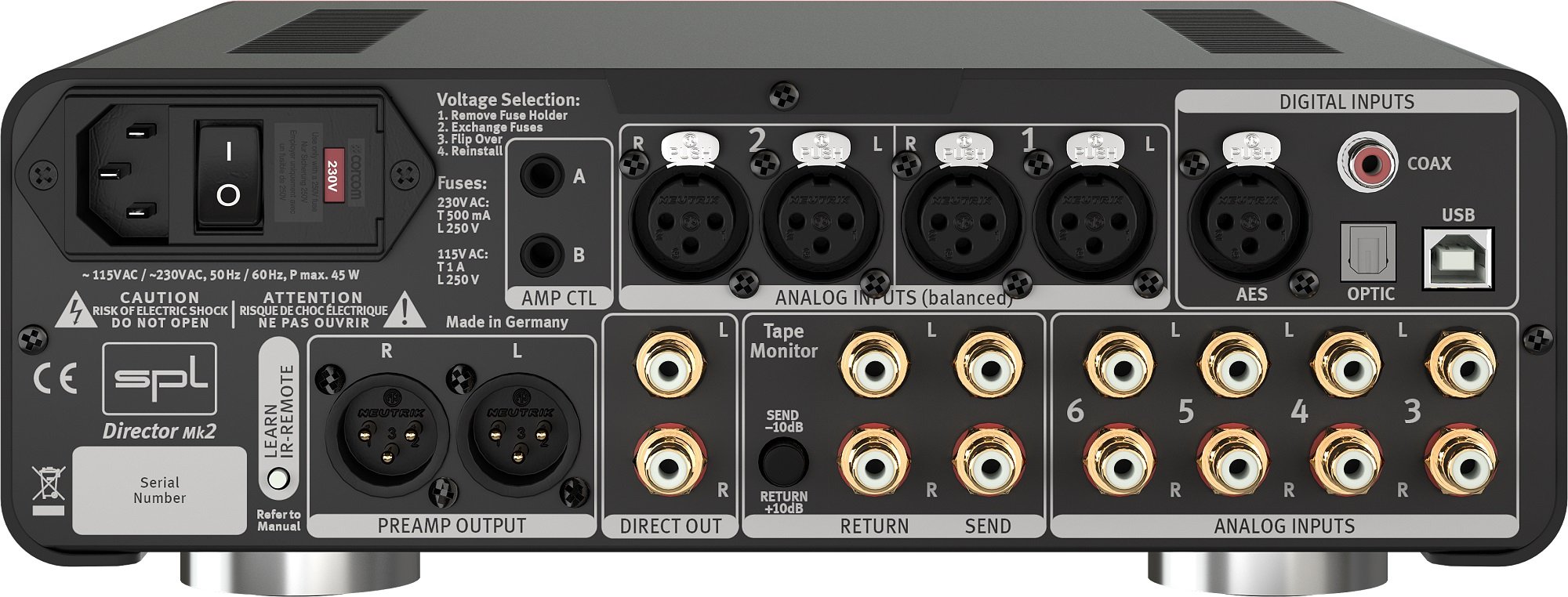
Reviews
There are no reviews yet.